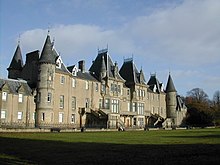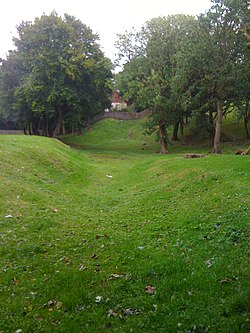Welcome to Visit Falkirk Places
The Walkfo guide to things to do & explore in Falkirk
![]() Visit Falkirk places using Walkfo for free guided tours of the best Falkirk places to visit. A unique way to experience Falkirk’s places, Walkfo allows you to explore Falkirk as you would a museum or art gallery with audio guides.
Visit Falkirk places using Walkfo for free guided tours of the best Falkirk places to visit. A unique way to experience Falkirk’s places, Walkfo allows you to explore Falkirk as you would a museum or art gallery with audio guides.
Visiting Falkirk Walkfo Preview
Falkirk is a large town in the Central Lowlands of Scotland, historically within the county of Stirlingshire . It lies in the Forth Valley, 23.3 miles (37.5 km) north-west of Edinburgh and 20.5 miles (33.0 km) south-east of Glasgow . The population of the town had risen to 34,570 according to a 2008 estimate, making it the 20th most populous settlement in Scotland . The town is at the junction of the Forth and Clyde and Union Canals . When you visit Falkirk, Walkfo brings Falkirk places to life as you travel by foot, bike, bus or car with a mobile phone & headphones.
Falkirk Places Overview: History, Culture & Facts about Falkirk
Visit Falkirk – Walkfo’s stats for the places to visit
With 47 audio plaques & Falkirk places for you to explore in the Falkirk area, Walkfo is the world’s largest heritage & history digital plaque provider. The AI continually learns & refines facts about the best Falkirk places to visit from travel & tourism authorities (like Wikipedia), converting history into an interactive audio experience.
Falkirk history

The Antonine Wall, which stretches across the centre of Scotland, passed through the town. Much of the best evidence of Roman occupation in Scotland has been found in Falkirk. The area was at the forefront of canal construction when the Forth and Clyde Canal opened in 1790. The Union Canal provided a link to Edinburgh and early railway development followed.
Battles of Falkirk
The Battle of Falkirk Muir took place on 17 January 1746 . The Jacobites defeated a government army commanded by Lieutenant General Henry Hawley .
Falkirk culture & places

Falkirk hosted a national arts festival which ran in Callendar Park from 2000-2009 called Big In Falkirk. After its inception in 2000, the festival won Scottish Thistle Award for Events & Festivals in 2005.
Media
Johnston Press was established by the Johnston family from Falkirk in 1767 . The family acquired the first newspaper, the Falkirk Herald, in 1846 . The publishing company was floated on the London Stock Exchange in 1988 .
Recreation
Callendar House is an imposing mansion with a 600-year history which is now a museum and also has a cafe and shop . The Park Gallery, a contemporary art gallery is also based in the house .
Landmarks
Falkirk Wheel is the only rotary canal connector in the world . In Falkirk High Street lies the Falkirk Steeple, the current building was built in 1814 and is protected as a category A listed building .
Religion
A percentage of people (29) belong to no religion, about 1% above the national figure . The Church of Scotland’s Presbytery of Falkirk includes congregations in Bo’ness, Bonnybridge, Cumbernauld, Grangemouth and Larbert .
Falkirk geography / climate

Falkirk sits at between 50 metres (164 ft) and 125 metres (410 ft) above sea level. The underlying geology of the town is characterised by glacial deposits. The area to the north of Falkirk is part of the floodplain of the River Carron.
Climate
Falkirk has a temperate maritime climate, which is relatively mild despite its northerly latitude . Winters are especially mild given that Moscow and Labrador lie on the same latitude . Summer temperatures are comparatively cool, with daily upper maxima rarely exceeding 23 °C (73 °F)
Why visit Falkirk with Walkfo Travel Guide App?
![]() You can visit Falkirk places with Walkfo Falkirk to hear history at Falkirk’s places whilst walking around using the free digital tour app. Walkfo Falkirk has 47 places to visit in our interactive Falkirk map, with amazing history, culture & travel facts you can explore the same way you would at a museum or art gallery with information audio headset. With Walkfo, you can travel by foot, bike or bus throughout Falkirk, being in the moment, without digital distraction or limits to a specific walking route. Our historic audio walks, National Trust interactive audio experiences, digital tour guides for English Heritage locations are available at Falkirk places, with a AI tour guide to help you get the best from a visit to Falkirk & the surrounding areas.
You can visit Falkirk places with Walkfo Falkirk to hear history at Falkirk’s places whilst walking around using the free digital tour app. Walkfo Falkirk has 47 places to visit in our interactive Falkirk map, with amazing history, culture & travel facts you can explore the same way you would at a museum or art gallery with information audio headset. With Walkfo, you can travel by foot, bike or bus throughout Falkirk, being in the moment, without digital distraction or limits to a specific walking route. Our historic audio walks, National Trust interactive audio experiences, digital tour guides for English Heritage locations are available at Falkirk places, with a AI tour guide to help you get the best from a visit to Falkirk & the surrounding areas.
“Curated content for millions of locations across the UK, with 47 audio facts unique to Falkirk places in an interactive Falkirk map you can explore.”
Walkfo: Visit Falkirk Places Map
47 tourist, history, culture & geography spots
Falkirk historic spots | Falkirk tourist destinations | Falkirk plaques | Falkirk geographic features |
| Walkfo Falkirk tourism map key: places to see & visit like National Trust sites, Blue Plaques, English Heritage locations & top tourist destinations in Falkirk | |||
Best Falkirk places to visit
Falkirk has places to explore by foot, bike or bus. Below are a selection of the varied Falkirk’s destinations you can visit with additional content available at the Walkfo Falkirk’s information audio spots:

Mumrills
Mumrills was the site of the largest Roman fort on the Antonine Wall in Scotland. It is possible that the fort could exchange signals with Flavian Gask Ridge forts. Some believe it may have been part of Wallace’s defeat at the Battle of Falkirk.

Grandsable Cemetery
Grandsable Cemetery lies on a small hill with views over the Firth of Forth. Unlike other cemeteries in the wider area it has almost no vandalism, probably due to its distance from any main town.

Callendar House
Callendar House is set within the grounds of Callendar Park in Falkirk, central Scotland. During the 19th century, it was redesigned and extended in the style of a French Renaissance château fused with elements of Scottish baronial architecture. The core of the building is a 14th-century tower house, with a 300 ft frontage.

Arthur’s O’on
Arthur’s O’on (Scots: Oven) was a stone building thought to be a probable Roman temple. It stood on rising ground above the north bank of the River Carron in Stenhousemuir, near Falkirk, Scotland.

Rosebank distillery
Rosebank distillery is situated in Camelon on the banks of the Forth and Clyde canal between Edinburgh and Glasgow. Ian MacLeod Distillers Ltd purchased the site from Scottish Canals and the trademarks from Diageo.

Falkirk Old Parish Church
Falkirk Old & St. Modan’s Parish Church is located in the centre of Falkirk, central Scotland. The medieval Old Parish Church may have been founded as early as the 7th century. The church was largely rebuilt in the 19th century, though the 18th-century steeple was retained. The building is protected as a category A listed building.

St Andrew’s West
St. Andrew’s West Parish Church is the largest church in Falkirk, Scotland, founded in 1843. The present Gothic building was built in 1896 at a cost of £8,100 to designs by architect James Strang. It is protected as a category C(s) listed building.

Falkirk Steeple
The Falkirk Steeple was built in 1814 and replaced an earlier steeple dating from the late 17th century. A stylised image of the steeple appears on the crest of Falkirk Football Club.

Falkirk Community Hospital
Falkirk Community Hospital is a community hospital in Falkirk, Scotland. It is managed by NHS Forth Valley and is part of the Forth Valley NHS.

Watling Lodge
Watling Lodge was a Roman fortlet on the Antonine Wall in Scotland. It was located near what is now Lock Sixteen on the Forth and Clyde Canal in Falkirk.
Visit Falkirk plaques
![]() 2
2
plaques
here Falkirk has 2 physical plaques in tourist plaque schemes for you to explore via Walkfo Falkirk plaques audio map when visiting. Plaques like National Heritage’s “Blue Plaques” provide visual geo-markers to highlight points-of-interest at the places where they happened – and Walkfo’s AI has researched additional, deeper content when you visit Falkirk using the app. Experience the history of a location when Walkfo local tourist guide app triggers audio close to each Falkirk plaque. Explore Plaques & History has a complete list of Hartlepool’s plaques & Hartlepool history plaque map.